名词所有格与名词性物主代词
- 格式:ppt
- 大小:696.50 KB
- 文档页数:16
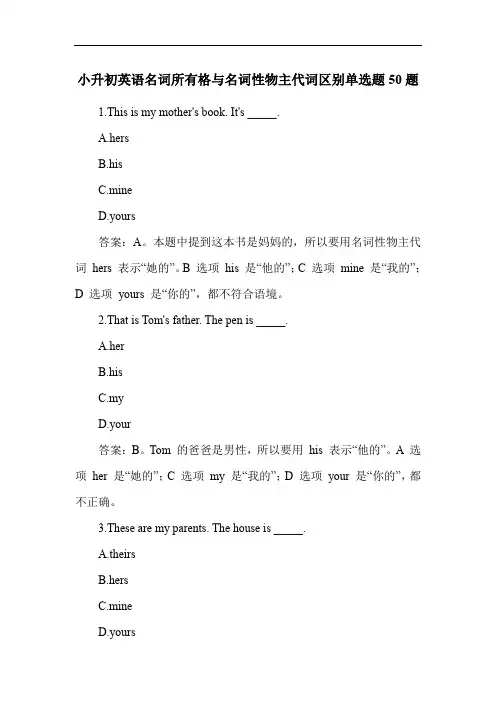
小升初英语名词所有格与名词性物主代词区别单选题50题1.This is my mother's book. It's _____.A.hersB.hisC.mineD.yours答案:A。
本题中提到这本书是妈妈的,所以要用名词性物主代词hers 表示“她的”。
B 选项his 是“他的”;C 选项mine 是“我的”;D 选项yours 是“你的”,都不符合语境。
2.That is Tom's father. The pen is _____.A.herB.hisC.myD.your答案:B。
Tom 的爸爸是男性,所以要用his 表示“他的”。
A 选项her 是“她的”;C 选项my 是“我的”;D 选项your 是“你的”,都不正确。
3.These are my parents. The house is _____.A.theirsB.hersC.mineD.yours答案:A。
父母是复数,所以要用theirs 表示“他们的”。
B 选项hers 是“她的”;C 选项mine 是“我的”;D 选项yours 是“你的”,都不适合。
4.This is Lily's sister. The toy is _____.A.hersB.hisC.itsD.ours答案:A。
Lily 的妹妹是女性,所以用hers 表示“她的”。
B 选项his 是“他的”;C 选项its 是“它的”;D 选项ours 是“我们的”,都不符合。
5.That is Mike's brother. The bike is _____.A.hersB.hisC.mineD.yours答案:B。
Mike 的哥哥是男性,用his 表示“他的”。
A 选项hers 是“她的”;C 选项mine 是“我的”;D 选项yours 是“你的”,均不合适。
6.This is not my pencil. It's _____.A.TomB.Tom'sD.Toms'答案:B。

一、人称代词分为第一人称、第二人称、第三人称;有主格和宾格两种形式;1.人称代词主格:作主语,表示谁怎么样了、干什么了;例:1I am a teacher. 2You are a student.3He is a student, too. 4We/You/They are students.2.人称代词宾格:作宾语,表示动作行为的对象;一般放在动词和介词之后;例:1Give it to me. 2Let’s go let’s =let us二、物主代词可分为形容词性物主代词和名词性物主代词;1、形容词性物主代词:起形容词的作用,用在名词前,用作定语,限定该名词的意义; 例:1 This is my book. 这是我的书;2 We love our motherland. 我们热爱我们的祖国;2. 名词性物主代词起名词的作用,后面无名词;例:1Look at the two pencils. The red one is yours and the blue one is mine.看那两支铅笔,红的是你的,蓝的是我的;2 He likes my pen. He doesn”t like hers. 他喜欢我的钢笔,不喜欢她的;3Lucy’s hair is longer than Lily's. 露西的头发比莉莉的更长;3.注意:在使用名词性物主代词时,必须有特定的语言环境,即要省略的名词大家已经知道,前文已经提起过;例:It’shers.是她的; 单独使用大家不知是怎么回事,不可以这样用Thereisabook.It’shers.那有本书;是她的; 先提及,大家才明白只有上文提及了某个名词,才会知道名词性物主代词指代的事物;4.名词性物主代词=形容词性物主代词+名词名词性物主代词在一定情况下可以用“形容词性物主代词+名词”来转换;有时为避免重复使用名词,也可用“名词性物主代词”来代替“形容词性物主代词+名词”的形式;例:1This is my ruler.=This ruler is mine.Those are his clothes.=Those clothes are his.2My bag is yellow, her bag is red, his bag is blue and your bag is pink. 为避免重复使用bag,可写成My bag形容词性 is yellow, hers名词性=her bagis red, his名词性=his bag is blue and yours名词性=your bag is pink.5形容词性物主代词和名词性物主代词的用法口诀:形容词性物主代词能力差,自己不能来当家,后面需把名词加;名词性物主代词能力强,自己独来又独往;6.形容词性物主代词变为名词性物主代词遵循“一二四”原则:一改my为 mine;二his its保持不变;四在your, her, their, our 后加上s;三、名词所有格:表示所有关系,通常在人或有生命的名词后加上’s或’来构成,表示“……的”;既可以当形容词性物主代词用,也可以当名词性物主代词用;名词所有格构成形式规律:1单数名词以及不以-s结尾的复数名词加’s;例:Tom’s book 汤姆的书Children’s Day儿童节2以结尾的复数名词只加’; 例:students’ schoolbags学生们的书包3表示两个人共同拥有某物时,只需将在后面的名词变为所有格形式;This is Lucy’s and Linda’s mother.这是露西和琳达的妈妈;4表示两个人各自拥有某物时,需将两个名词变为所有格形式;These are Jim’s andTom’s toys.这些是吉姆和汤姆的玩具;=These toys are Jim’s andTom’s.介词in 的用法1“in+表示语言的名词”意为“用某种语言说,用某种语言表达”例:in Chinese 用中文说 in English用英语说2表示“在几年几班或在哪所学校”时要用介词in,此时in意为“在……里面”;例:in Beijing International school在北京国际学校 in Class One,Grade Seven在七年一班3“in+颜色”表示穿某种颜色的服装“in+a/an+颜色+单数的服装名称”表示穿一件某种颜色的服装“in+颜色+复数的服装名称”表示穿某种颜色的服装in yellow穿黄色衣服 in a yellow shirt穿一件黄色的衬衫in yellow pants穿一条蓝色长裤。

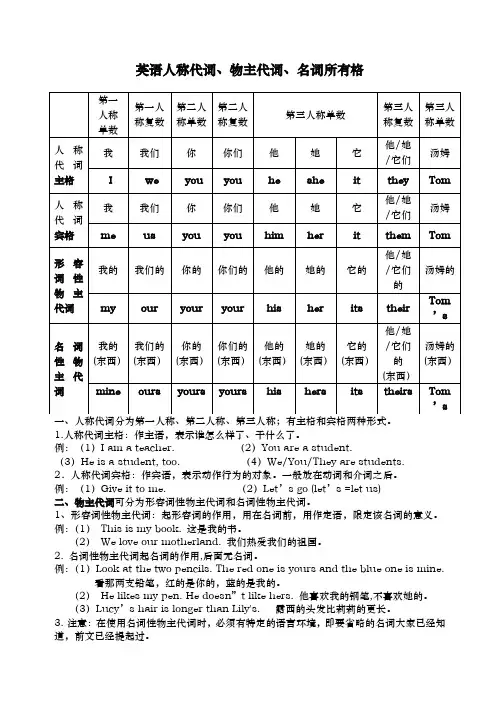
英语人称代词、物主代词、名词所有格1.人称代词主格:作主语,表示谁怎么样了、干什么了。
例:(1)I am a teacher. (2)You are a student.(3)He is a student, too. (4)We/You/They are students.2.人称代词宾格:作宾语,表示动作行为的对象。
一般放在动词和介词之后。
例:(1)Give it to me. (2)Let’s go (let’s =let us)二、物主代词可分为形容词性物主代词和名词性物主代词。
1、形容词性物主代词:起形容词的作用,用在名词前,用作定语,限定该名词的意义。
例:(1)This is my book. 这是我的书。
(2)We love our motherland. 我们热爱我们的祖国。
2. 名词性物主代词起名词的作用,后面无名词。
例:(1)Look at the two pencils. The red one is yours and the blue one is mine.看那两支铅笔,红的是你的,蓝的是我的。
(2)He likes my pen. He doesn”t like hers. 他喜欢我的钢笔,不喜欢她的。
(3)Lucy’s hair is longer than Lily's. 露西的头发比莉莉的更长。
3. 注意:在使用名词性物主代词时,必须有特定的语言环境,即要省略的名词大家已经知道,前文已经提起过。
例:It’s hers. 是她的。
(单独使用大家不知是怎么回事,不可以这样用)There is a book. It’s hers. 那有本书。
是她的。
(先提及,大家才明白)只有上文提及了某个名词,才会知道名词性物主代词指代的事物。
4. 名词性物主代词=形容词性物主代词+名词名词性物主代词在一定情况下可以用“形容词性物主代词+名词”来转换;有时为避免重复使用名词,也可用“名词性物主代词”来代替“形容词性物主代词+名词”的形式。
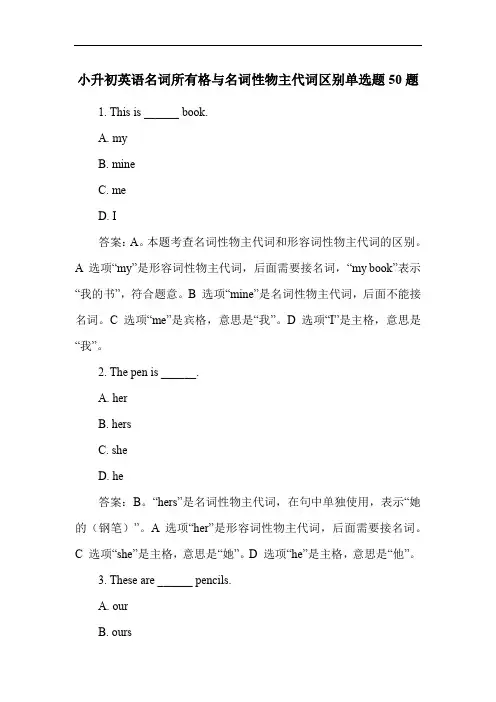
小升初英语名词所有格与名词性物主代词区别单选题50题1. This is ______ book.A. myB. mineC. meD. I答案:A。
本题考查名词性物主代词和形容词性物主代词的区别。
A 选项“my”是形容词性物主代词,后面需要接名词,“my book”表示“我的书”,符合题意。
B 选项“mine”是名词性物主代词,后面不能接名词。
C 选项“me”是宾格,意思是“我”。
D 选项“I”是主格,意思是“我”。
2. The pen is ______.A. herB. hersC. sheD. he答案:B。
“hers”是名词性物主代词,在句中单独使用,表示“她的(钢笔)”。
A 选项“her”是形容词性物主代词,后面需要接名词。
C 选项“she”是主格,意思是“她”。
D 选项“he”是主格,意思是“他”。
3. These are ______ pencils.A. ourB. oursC. weD. us答案:A。
“our”是形容词性物主代词,后接名词“pencils”,表示“我们的铅笔”。
B 选项“ours”是名词性物主代词,不能接名词。
C 选项“we”是主格。
D 选项“us”是宾格。
4. That bag is not ______.A. myB. mineC. meD. I答案:B。
“mine”在这里表示“我的((包)”,是名词性物主代词,可单独使用。
A 选项“my”后需接名词。
C 选项“me”是宾格。
D 选项“I”是主格。
5. ______ classroom is big.A. OurB. OursC. WeD. Us答案:A。
“Our”是形容词性物主代词,修饰名词“classroom”,表示“我们的教室”。
B 选项“Ours”是名词性物主代词,不能修饰名词。
C 选项“We”是主格。
D 选项“Us”是宾格。
6. This is not my room. It's ________.A. my parents'B. my parent'sC. my parentsD. parents'答案:A。
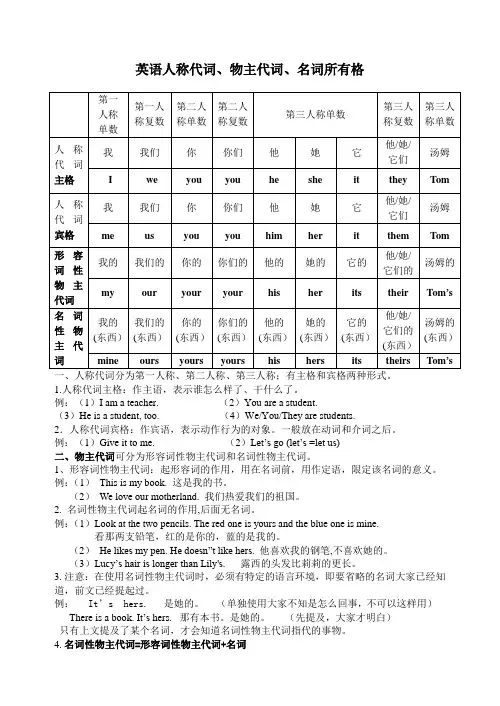
英语人称代词、物主代词、名词所有格1.人称代词主格:作主语,表示谁怎么样了、干什么了。
例:(1)I am a teacher. (2)You are a student.(3)He is a student, too. (4)We/You/They are students.2.人称代词宾格:作宾语,表示动作行为的对象。
一般放在动词和介词之后。
例:(1)Give it to me. (2)Let’s go (let’s =let us)二、物主代词可分为形容词性物主代词和名词性物主代词。
1、形容词性物主代词:起形容词的作用,用在名词前,用作定语,限定该名词的意义。
例:(1)This is my book. 这是我的书。
(2)We love our motherland. 我们热爱我们的祖国。
2. 名词性物主代词起名词的作用,后面无名词。
例:(1)Look at the two pencils. The red one is yours and the blue one is mine.看那两支铅笔,红的是你的,蓝的是我的。
(2)He likes my pen. He doesn”t like hers. 他喜欢我的钢笔,不喜欢她的。
(3)Lucy’s hair is longer than Lily's. 露西的头发比莉莉的更长。
3. 注意:在使用名词性物主代词时,必须有特定的语言环境,即要省略的名词大家已经知道,前文已经提起过。
例:It’s hers. 是她的。
(单独使用大家不知是怎么回事,不可以这样用)There is a book. It’s hers. 那有本书。
是她的。
(先提及,大家才明白)只有上文提及了某个名词,才会知道名词性物主代词指代的事物。
4. 名词性物主代词=形容词性物主代词+名词名词性物主代词在一定情况下可以用“形容词性物主代词+名词”来转换;有时为避免重复使用名词,也可用“名词性物主代词”来代替“形容词性物主代词+名词”的形式。
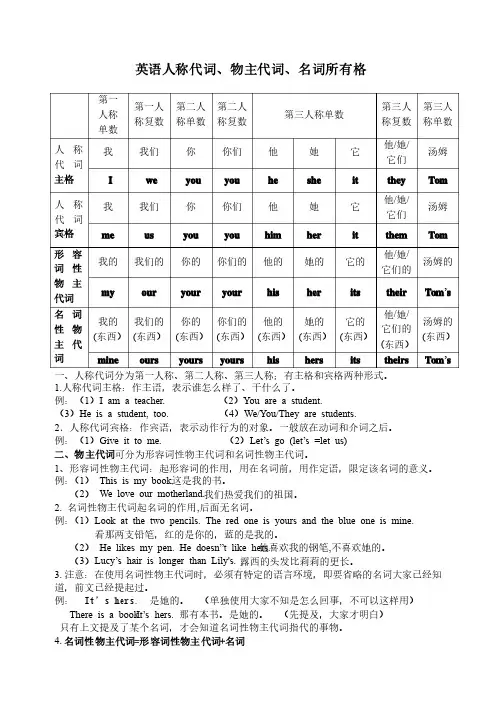
第一人称单数单数 第一人称复数称复数 第二人称单数称单数 第二人称复数称复数 第三人称单数第三人称单数 第三人称复数称复数 第三人称单数称单数 人称代词主格我 我们我们 你 你们你们 他 她 它 他/她/它们它们 汤姆汤姆 I we you you he she it they Tom 人称代词宾格我 我们我们 你 你们你们 他 她 它 他/她/它们它们 汤姆汤姆 me us you you him her it them Tom 形容词性物主代词我的我的 我们的我们的 你的你的 你们的你们的 他的他的 她的她的 它的它的 他/她/它们的它们的 汤姆的汤姆的 my our your your his her its their Tom ’s 名词性物我的我的 (东西) 我们的我们的 (东西)东西) 你的你的 (东西) 你们的你们的 (东西) 他的他的 (东西) 她的她的 (东西) 它的它的 (东西) 他/她/它们的它们的 汤姆的(东西)1.These are ( (2.Those books are . .(他们的)(他们的)3.Is this photo (你的)?(你的)?4.Is this (你的)5. (它的) 6. (她)7.The eraser is for .(她)(她) 8.Is this (她的)9.Is this bag (她的)?(她的)? 10.I don’t like .((他们)(他们) 11. (他们)12. (他们的)13.The old shoes are . .(他们的)(他们的) 14.This potato is . .((我的)(我的) 15.That tomato is .(你的)(你的) 16.This is (我的)17.That is (你的)18. 19.He will catch up with .(我们)20.The red bike is . .((他的)(他的) 21.I am worried about . .((他)(他) 22.That eraser is . (Bill 23. (我们的)(我们的) 24.These are not ( 25.The big and bright classroom is (我们的)6. Here are many dolls, which one is _________ ? ( she ) 7. I can find my toy, but where’s _________? ( you )8. Show _________ your kite, OK? (they) 9. I have a beautiful cat. _________name is Mimi. These cakes are _________. ( it ) 10. 10. Are Are Are these these these ________ ________ ________ tickets? tickets? tickets? No, No, No, ________ ________ ________ are are are not not not _________. _________. _________. ________ ________ ________ aren’t aren’t aren’t here. here. ( they ) 11. Shall _________ have a look at that classroom? That is _________ classroom. ( we ) 12. _________ is my aunt. Do you know _________ job? _________ is a nurse. ( she ) 13. That is not _________ camera. _________is at home. ( he ) 14. Where are _________? I can’t find _________. Let’s call _________ parents. ( they )15. Don’t touch _________. _________ not a cat, _________ a tiger!(it )16. _________ sister is ill. Please go and get _________. ( she ) 17. _________ don’t know her name. Would you please tell _________. ( we )18. So many dogs. Let’s count _________. ( they )19. I have a lovely brother. _________ is only 3. I like _________ very much. ( he ) 20. May I sit beside _________? ( you ) 21. Look at that desk. Those book are on _________. ( it )22.The girl behind _________ is our friend. (she ) 23. There is a letter for ________ (she) mother. 24.That is _____ (she ) coat. The coat is red. ______ (its)is a new one. 25. Whose pens are these? _______(their) are ______ (we). 26.Give _______(he) a toy, please. 27.________(we) eyes are black. _______ (us) come from Japan. 28.Tim and Bill are twins. _______ (their )are from England. _________ (them) parents are teachers in No 6 school. 29.Give the book to __________(I ). 30. These books are __________(we). 三、填上正确的人称代词和物主代词三、填上正确的人称代词和物主代词1. _____ is my friend. 他是我的朋友。
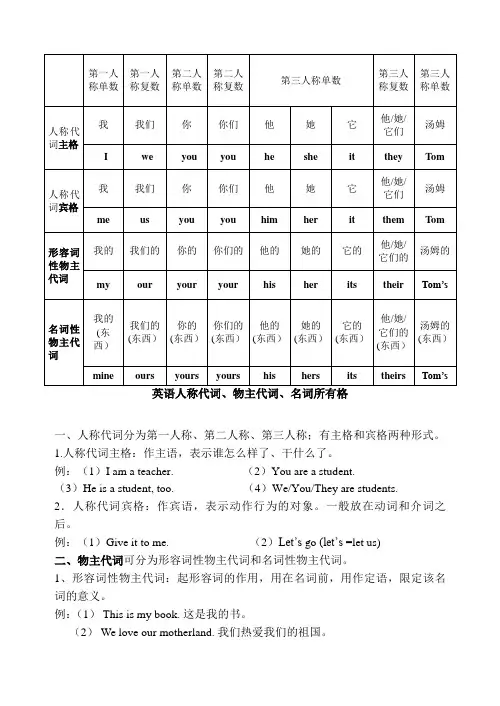
一、人称代词分为第一人称、第二人称、第三人称;有主格和宾格两种形式。
1.人称代词主格:作主语,表示谁怎么样了、干什么了。
例:(1)I am a teacher.(2)You are a student.(3)He is a student, too.(4)We/You/They are students.2.人称代词宾格:作宾语,表示动作行为的对象。
一般放在动词和介词之后。
例:(1)Give it to me.(2)Let’s go (let’s =let us)二、物主代词可分为形容词性物主代词和名词性物主代词。
1、形容词性物主代词:起形容词的作用,用在名词前,用作定语,限定该名词的意义。
例:(1) This is my book. 这是我的书。
(2) We love our motherland. 我们热爱我们的祖国。
2. 名词性物主代词起名词的作用,后面无名词。
例:(1)Look at the two pencils. The red one is yours and the blue one is mine.看那两支铅笔,红的是你的,蓝的是我的。
(2) He likes my pen. He doesn”t like hers. 他喜欢我的钢笔,不喜欢她的。
(3)Lucy’s hair is longer than Lily's. 露西的头发比莉莉的更长。
3. 注意:在使用名词性物主代词时,必须有特定的语言环境,即要省略的名词大家已经知道,前文已经提起过。
例:It’s hers. 是她的。
(单独使用大家不知是怎么回事,不可以这样用)There is a book. It’s hers. 那有本书。
是她的。
(先提及,大家才明白)只有上文提及了某个名词,才会知道名词性物主代词指代的事物。
4. 名词性物主代词=形容词性物主代词+名词名词性物主代词在一定情况下可以用“形容词性物主代词+名词”来转换;有时为避免重复使用名词,也可用“名词性物主代词”来代替“形容词性物主代词+名词”的形式。

一、人称代词分为第一人称、第二人称、第三人称;有主格和宾格两种形式。
1.人称代词主格:作主语,表示谁怎么样了、干什么了。
例:(1)I am a teacher.(2)You are a student.(3)He is a student, too.(4)We/You/They are students.2.人称代词宾格:作宾语,表示动作行为的对象。
一般放在动词和介词之后。
例:(1)Give it to me.(2)Let’s go (let’s =let us)二、物主代词可分为形容词性物主代词和名词性物主代词。
1、形容词性物主代词:起形容词的作用,用在名词前,用作定语,限定该名词的意义。
例:(1) This is my book. 这是我的书。
(2) We love our motherland. 我们热爱我们的祖国。
2. 名词性物主代词起名词的作用,后面无名词。
例:(1)Look at the two pencils. The red one is yours and the blue one is mine.看那两支铅笔,红的是你的,蓝的是我的。
(2) He likes my pen. He doesn”t like hers. 他喜欢我的钢笔,不喜欢她的。
(3)Lucy’s hair is longer than Lily's. 露西的头发比莉莉的更长。
3. 注意:在使用名词性物主代词时,必须有特定的语言环境,即要省略的名词大家已经知道,前文已经提起过。
例:It’s hers. 是她的。
(单独使用大家不知是怎么回事,不可以这样用)There is a book. It’s hers. 那有本书。
是她的。
(先提及,大家才明白)只有上文提及了某个名词,才会知道名词性物主代词指代的事物。
4. 名词性物主代词=形容词性物主代词+名词名词性物主代词在一定情况下可以用“形容词性物主代词+名词”来转换;有时为避免重复使用名词,也可用“名词性物主代词”来代替“形容词性物主代词+名词”的形式。
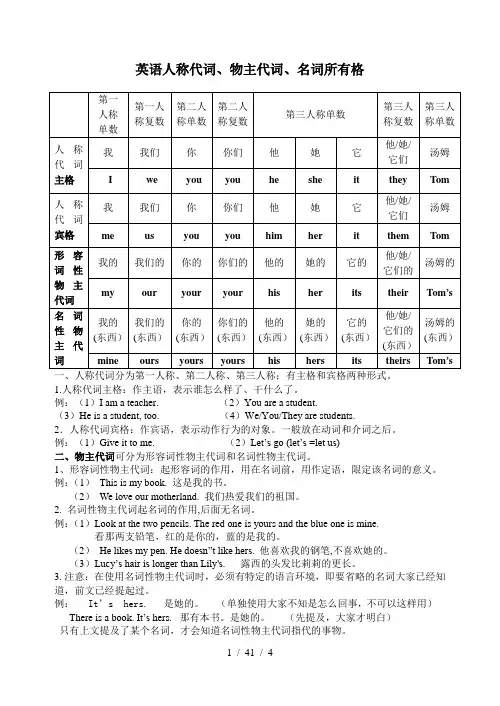
英语人称代词、物主代词、名词所有格1.人称代词主格:作主语,表示谁怎么样了、干什么了。
例:(1)I am a teacher. (2)You are a student.(3)He is a student, too. (4)We/You/They are students.2.人称代词宾格:作宾语,表示动作行为的对象。
一般放在动词和介词之后。
例:(1)Give it to me. (2)Let’s go (let’s =let us)二、物主代词可分为形容词性物主代词和名词性物主代词。
1、形容词性物主代词:起形容词的作用,用在名词前,用作定语,限定该名词的意义。
例:(1)This is my book. 这是我的书。
(2)We love our motherland. 我们热爱我们的祖国。
2. 名词性物主代词起名词的作用,后面无名词。
例:(1)Look at the two pencils. The red one is yours and the blue one is mine.看那两支铅笔,红的是你的,蓝的是我的。
(2)He likes my pen. He doesn”t like hers. 他喜欢我的钢笔,不喜欢她的。
(3)Lucy’s hair is longer than Lily's. 露西的头发比莉莉的更长。
3. 注意:在使用名词性物主代词时,必须有特定的语言环境,即要省略的名词大家已经知道,前文已经提起过。
例:It’s hers. 是她的。
(单独使用大家不知是怎么回事,不可以这样用)There is a book. It’s hers. 那有本书。
是她的。
(先提及,大家才明白)只有上文提及了某个名词,才会知道名词性物主代词指代的事物。
4. 名词性物主代词=形容词性物主代词+名词名词性物主代词在一定情况下可以用“形容词性物主代词+名词”来转换;有时为避免重复使用名词,也可用“名词性物主代词”来代替“形容词性物主代词+名词”的形式。

英语人称代词、物主代词、名词所有格形式..1.人称代词主格:作主语;表示谁怎么样了、干什么了..例:1I am a teacher. 2You are a student.3He is a student; too. 4We/You/They are students. 2.人称代词宾格:作宾语;表示动作行为的对象..一般放在动词和介词之后..例:1Give it to me. 2Let’s go let’s =let us二、物主代词可分为形容词性物主代词和名词性物主代词..1、形容词性物主代词:起形容词的作用;用在名词前;用作定语;限定该名词的意义..例:1 This is my book. 这是我的书..2 We love our motherland. 我们热爱我们的祖国..2. 名词性物主代词起名词的作用;后面无名词..例:1Look at the two pencils. The red one is yours and the blue one is mine.看那两支铅笔;红的是你的;蓝的是我的..2 He likes my pen. He doesn”t like hers. 他喜欢我的钢笔;不喜欢她的..3Lucy’s hair is longer than Lily's. 露西的头发比莉莉的更长..3. 注意:在使用名词性物主代词时;必须有特定的语言环境;即要省略的名词大家已经知道;前文已经提起过..例:It’s hers. 是她的.. 单独使用大家不知是怎么回事;不可以这样用There is a book. It’s hers. 那有本书..是她的.. 先提及;大家才明白只有上文提及了某个名词;才会知道名词性物主代词指代的事物..4. 名词性物主代词=形容词性物主代词+名词名词性物主代词在一定情况下可以用“形容词性物主代词+名词”来转换;有时为避免重复使用名词;也可用“名词性物主代词”来代替“形容词性物主代词+名词”的形式..例:1This is my ruler.=This ruler is mine.Those are his clothes.=Those clothes are his.2My bag is yellow; her bag is red; his bag is blue and your bagis pink.为避免重复使用bag;可写成My bag形容词性 is yellow; hers名词性=her bag is red; his名词性=his bag is blue and yours名词性=yourbag is pink.5形容词性物主代词和名词性物主代词的用法口诀:形容词性物主代词能力差;自己不能来当家;后面需把名词加..名词性物主代词能力强;自己独来又独往..6.形容词性物主代词变为名词性物主代词遵循“一二四”原则:一改my为 mine;二his its保持不变;四在your; her; their; our 后加上s..三、名词所有格:表示所有关系;通常在人或有生命的名词后加上’s或’来构成;表示“……的”;既可以当形容词性物主代词用;也可以当名词性物主代词用..名词所有格构成形式规律:1单数名词以及不以-s结尾的复数名词加’s..例:Tom’s book 汤姆的书 Children’s Day儿童节2以结尾的复数名词只加’.. 例:students’ schoolbags学生们的书包3表示两个人共同拥有某物时;只需将在后面的名词变为所有格形式..This is Lucy’s and Linda’s mother.这是露西和琳达的妈妈..4表示两个人各自拥有某物时;需将两个名词变为所有格形式..These are Jim’s andTom’s toys.这些是吉姆和汤姆的玩具..=These toys are Jim’s andTom’s.练习题一. 把小括号的人称代词翻译成英语1.These are 他们的 flowers.2.Those booksare .他们的3.Is this photo 你的4.Is this 你的photo5. 它的eyes are blue.6. 她is my mother.7.The eraser is for .她 8.Is this 她的bag9.Is this bag 她的10.I don’tlike .他们11. 他们are lazy pupils. 12. 他们的shoes are old.13.The old shoes are .他们的14.This potatois .我的15.That tomato is .你的 16.This is 我的potato.17.That is 你的tomato. 18. 他的bike is red.19.He will catch up with .我们. 20.The red bike is .他的21.I am worried about .他22.That eraser is . Bill的23. 我们的 classroom is big and bright.24.These are not 康康的 shoes.They’re 王伟的.25.The big and bright classroom is 我们的.二.用所给词的适当形式填空..1. That is not _________ kite. That kite is very small; but _________ is very big. I2. The dress is _________. Give it to _________. she3. Is th is _________ watch you No; it’s not _________ . I4. _________ is my brother. ________ name is Jack. Look Those stamps are _________. he5. _________ dresses are red. we What colour are _________ you6. Here are many dolls; which one is _________ she7. I can find my toy; but where’s _________ you8. Show _________ your kite; OK they9. I have a beautiful cat. _________name is Mimi. These cakes are _________. it10. Are these ________ tickets No; ________ are not _________. ________ aren’t here. they11. Shall _________ have a look at that classroom That is _________ classroom. we12. _________ is my aunt. Do you know _________ job _________ isa nurse. she13. That is not _________ camera. _________is at home. he14. Where ar e _________ I can’t find _________. Let’s call _________ parents. they15. Don’t touch _________. _________ not a cat; _________ a tigerit16. _________ sister is ill. Please go and get _________. she17. _________ don’t know her name. Would you pleas e tell _________. we18. So many dogs. Let’s count _________. they19. I have a lovely brother. _________ is only 3. I like _________ very much. he20. May I sit beside _________ you21. Look at that desk. Those book are on _________. it22.The girl behind _________ is our friend. she23. There is a letter for ________ she mother.24.That is _____ she coat. The coat is red. ______ itsis a newone.25. Whose pens are these _______their are ______ we.26.Give _______he a toy; please.27.________we eyes are black. _______ us come from Japan.28.Tim and Bill are twins. _______ theirare from England._________ them parents are teachers in No 6 school.29.Give the book to __________I .30. These books are __________we.三、填上正确的人称代词和物主代词1. _____ is my friend. 他是我的朋友..2. My dog likes _____.我的狗喜欢她..3. Who is there It’s _____. 是谁啊是我..4.This is _____ father.这是我的爸爸..5. Come with _____. 跟我来..6. ______ are Chinese.我们是中国人..7. These are ______ photos. 这些是我们的照片..8. ____ like ______ car. 我喜欢他们的小汽车..9. _____ like ______ very much. 他们非常喜欢它..10. Let _____ give _____ a book. 让我给你一本书..11. I want to buy some balloons for ______. 我想买些气球送给他..12. Is that bike ______ Yes; it’s ______. 那辆自行车是你的吗是;它是我的..13. ______ classroom is bigger than _____. 你们的教室比我们的要大..14.Our school is here; and _______ is there. 我们的学校在这儿;他们的在那儿..15.Whose bike is this It’s ______ = _____ ______. 这是谁的自行车是她的..16. Is that car ______ Yes; it’s ______. 那辆车是你的吗是的;它是我的..17.Miss Zhang is Chinese teacher.张小姐是康康和王强的中文老师..18.These are school uniforms..这些是Kate和Maria校服..四、同义句转换..1、That is her skirt.2、This is your book.3、These are its babies.4、Those are their shoes.5、This coat is his.6、Those blue pants are ours.7、That is Bill’s shirt.8、These are Mike’s and Jim’s bikes.介词in用法1“in+表示语言的名词”意为“用某种语言说;用某种语言表达”例:in Chinese 用中文说 in English用英语说2表示“在几年几班或在哪所学校”时要用介词in;此时in意为“在……里面”..例:in Beijing International school在北京国际学校 in Class One;Grade Seven在七年一班3“in+颜色”表示穿某种颜色的服装“in+a/an+颜色+单数的服装名称”表示穿一件某种颜色的服装“in+颜色+复数的服装名称”表示穿某种颜色的服装in yellow穿黄色衣服 in a yellow shirt穿一件黄色的衬衫in yellow pants穿一条蓝色长裤练习题将下列各题翻译成英文..1、这个穿着紫色衣服的男孩是我的学生..2、我妹妹穿着一条粉红色的短裙..3、那些用日语怎么说4、Jane在九年三班..5、Bill、 Peter和我在同一所学校;但是在不同班级.._________________________________________________________ _______________6、Michael带着一顶绿色的帽子;穿着一双蓝色的鞋子.._________________________________________________________ _______________7、那两个穿白色长裙的女孩子是谁8、王丽穿着一件红色的衬衫;一条褐色的裤子和一双褐色的鞋子.._________________________________________________________ _______________。
一、人称代词分为第一人称、第二人称、第三人称;有主格和宾格两种形式。
1.人称代词主格:作主语,表示谁怎么样了、干什么了。
例:(1)I am a teacher.(2)You are a student.(3)He is a student, too.(4)We/You/They are students。
2.人称代词宾格:作宾语,表示动作行为的对象.一般放在动词和介词之后.例:(1)Give it to me.(2)Let’s go (let’s =let us)二、物主代词可分为形容词性物主代词和名词性物主代词。
1、形容词性物主代词:起形容词的作用,用在名词前,用作定语,限定该名词的意义。
例:(1) This is my book。
这是我的书。
(2) We love our motherland. 我们热爱我们的祖国。
2. 名词性物主代词起名词的作用,后面无名词。
例:(1)Look at the two pencils. The red one is yours and the blue one is mine.看那两支铅笔,红的是你的,蓝的是我的。
(2) He likes my pen. He doesn”t like hers. 他喜欢我的钢笔,不喜欢她的。
(3)Lucy’s hair is longer than Lily’s.露西的头发比莉莉的更长。
3. 注意:在使用名词性物主代词时,必须有特定的语言环境,即要省略的名词大家已经知道,前文已经提起过。
例:It’s hers。
是她的。
(单独使用大家不知是怎么回事,不可以这样用)There is a book. It's hers。
那有本书.是她的. (先提及,大家才明白)只有上文提及了某个名词,才会知道名词性物主代词指代的事物。
4. 名词性物主代词=形容词性物主代词+名词名词性物主代词在一定情况下可以用“形容词性物主代词+名词"来转换;有时为避免重复使用名词,也可用“名词性物主代词"来代替“形容词性物主代词+名词”的形式.例:(1)This is my ruler.=This ruler is mine.Those are his clothes。
一、人称代词分为第一人称、第二人称、第三人称;有主格和宾格两种形式. 1。
人称代词主格:作主语,表示谁怎么样了、干什么了。
例:(1)I am a teacher.(2)You are a student.(3)He is a student, too。
(4)We/You/They are students.2.人称代词宾格:作宾语,表示动作行为的对象。
一般放在动词和介词之后。
例:(1)Give it to me.(2)Let’s go (let’s =let us)二、物主代词可分为形容词性物主代词和名词性物主代词。
1、形容词性物主代词:起形容词的作用,用在名词前,用作定语,限定该名词的意义。
例:(1) This is my book。
这是我的书。
(2) We love our motherland. 我们热爱我们的祖国。
2. 名词性物主代词起名词的作用,后面无名词.例:(1)Look at the two pencils。
The red one is yours and the blue one is mine。
看那两支铅笔,红的是你的,蓝的是我的。
(2) He likes my pen. He doesn”t like hers. 他喜欢我的钢笔,不喜欢她的.(3)Lucy's hair is longer than Lily’s.露西的头发比莉莉的更长。
3。
注意:在使用名词性物主代词时,必须有特定的语言环境,即要省略的名词大家已经知道,前文已经提起过。
例:It's hers. 是她的. (单独使用大家不知是怎么回事,不可以这样用)There is a book。
It’s hers. 那有本书。
是她的。
(先提及,大家才明白)只有上文提及了某个名词,才会知道名词性物主代词指代的事物。
4. 名词性物主代词=形容词性物主代词+名词名词性物主代词在一定情况下可以用“形容词性物主代词+名词"来转换;有时为避免重复使用名词,也可用“名词性物主代词”来代替“形容词性物主代词+名词”的形式。